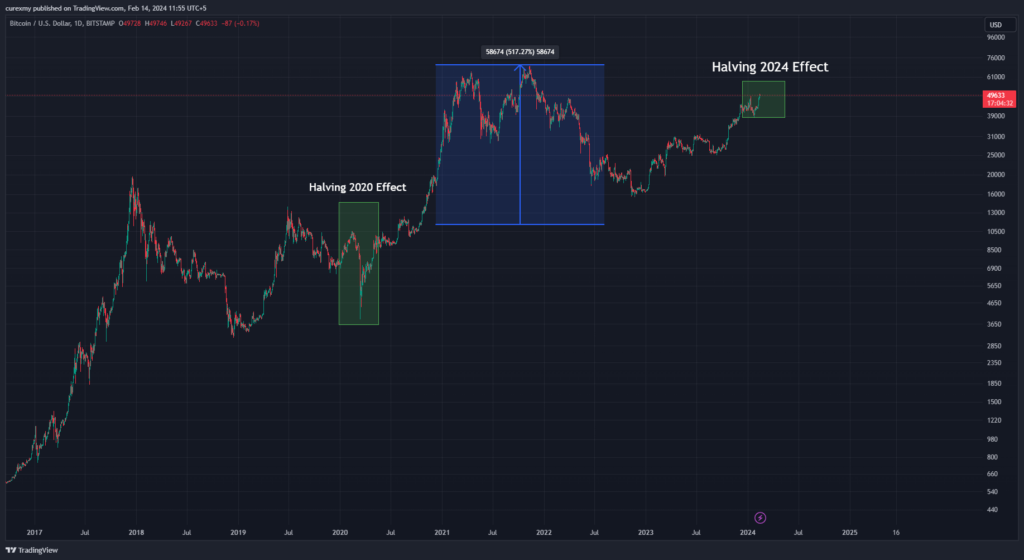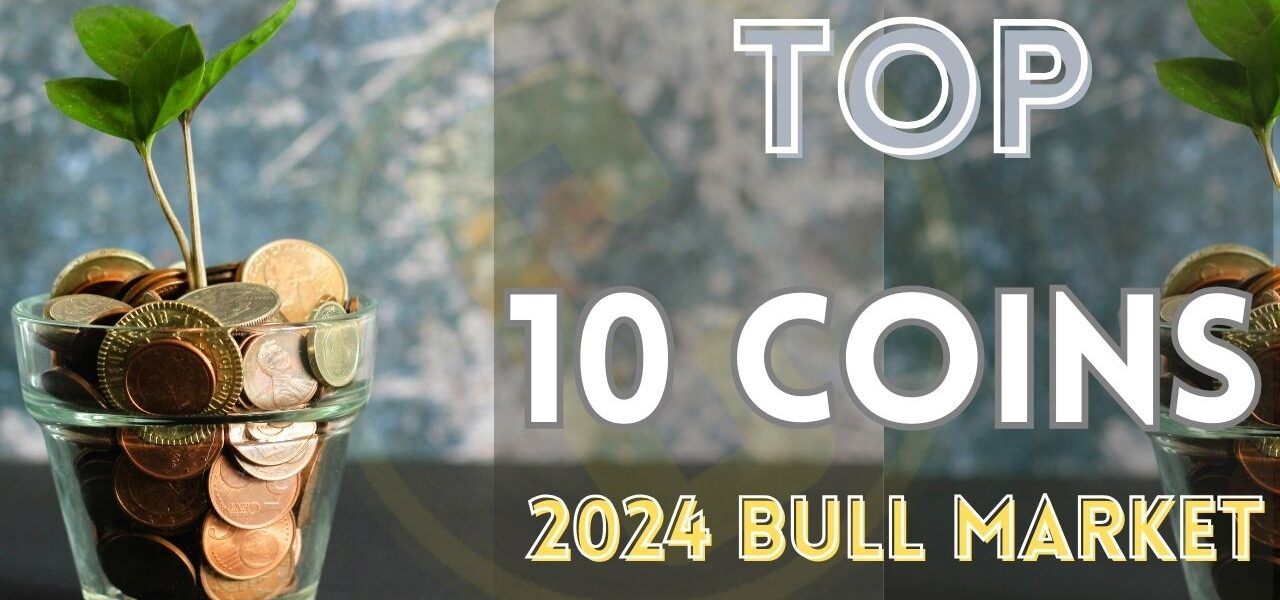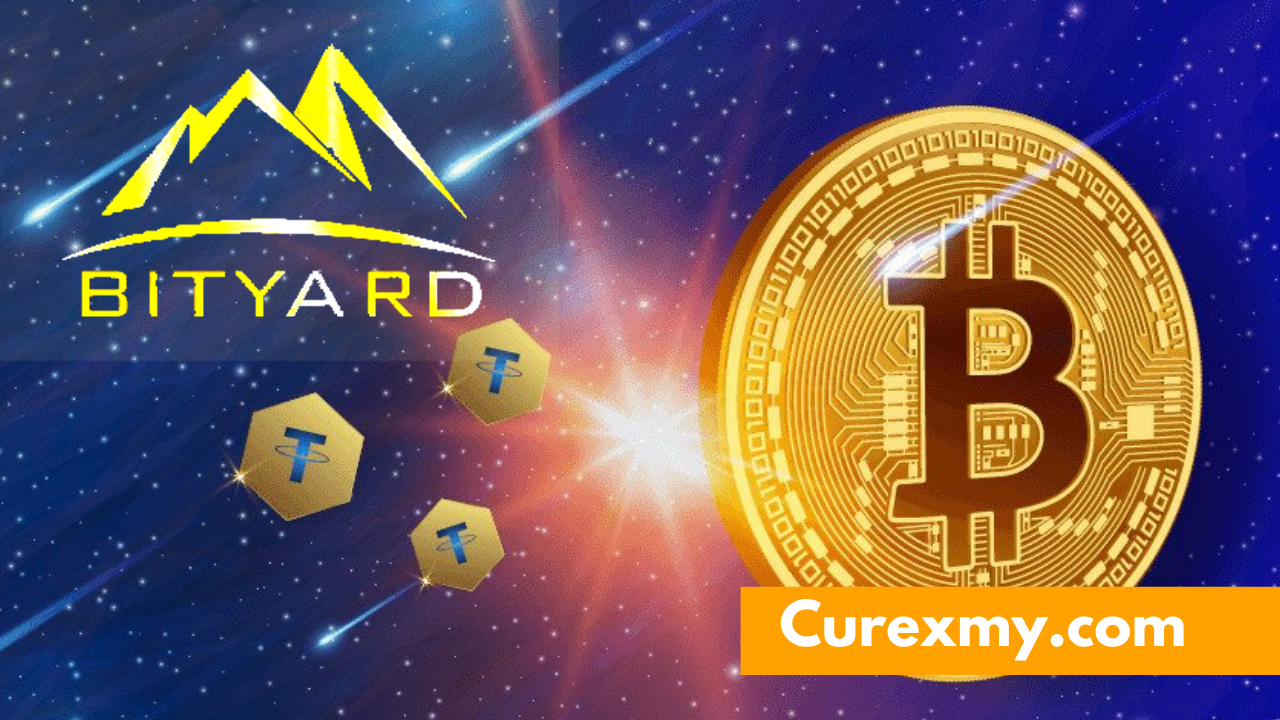Now is the time to prepare for the start of the bull market. You can begin your journey in the bull market with a strong crypto project to ensure a good profit at the market’s peak. As we all know, in April 2024, the market will reach a critical time with the occurrence of the Bitcoin halving, leading to a halving of the block reward for Bitcoin block mining. This significant event will reduce the total supply of Bitcoin in circulation, ultimately impacting the price of BTC to reach an all-time high.
Historically, Bitcoin halving events have proven to be significant in terms of price and overall crypto adoption worldwide. The 2020 event led to a surge in the BTC price from 19,000 USD to approximately 70,000 USD. This four-year recursive cycle is repeated in the BTC blockchain every four years. Strong projects like Ethereum, Chainlink, Uniswap, and XRP reached their all-time highs, benefiting their investors as the best-performing assets in the world.

Nav Posted Content
Spot BTC ETF Approval Event
The Bitcoin Spot ETF approval in January 2024 has opened the door for significant investment in the market. This development will have a substantial global impact, leading to a surge in the value of existing coins and creating opportunities for new projects to thrive. It’s time to consider high, mid, and low cap investing in the gem coins for the next 5 to 15 months.
10 Factors to Consider Before Investing in any Cryptocurrency:
- Team & Development:
- Legitimate developers with proven track records and transparent development roadmap.
- Sustainable and legal revenue model supporting the project’s long-term viability.
- Technology & Infrastructure:
- Robust and scalable blockchain technology underlying the cryptocurrency.
- User-friendly wallets and secure infrastructure to store and manage your holdings.
- Liquidity & Availability:
- Listed on reputable cryptocurrency exchanges with sufficient trading volume.
- Readily available for buying and selling with minimal liquidity risks.
- Use Cases & Adoption:
- Clear and practical use cases within the blockchain ecosystem or real world.
- Evidence of adoption by businesses, organizations, or individuals.
- Community & Social Engagement:
- Active and engaged community on multiple platforms, including social media and forums.
- Transparent communication from the development team about project progress and updates.
- Regulation & Compliance:
- Operates within the legal and regulatory frameworks of relevant jurisdictions.
- Avoids major security concerns or potential violations of user privacy.
- Tokenomics & Distribution:
- Clear and transparent token distribution model with defined roles for each type of token.
- Sustainable inflation and deflation mechanisms to prevent excessive volatility.
- Market Sentiment & Volatility:
- Understand the inherent volatility of the cryptocurrency market and be prepared for fluctuations.
- Conduct thorough research and avoid impulsive investment decisions based on hype or FOMO.
- Diversification & Risk Management:
- Diversify your cryptocurrency portfolio across different projects with varying risk profiles.
- Never invest more than you can afford to lose and manage your risk exposure responsibly.
- Independent Research & Due Diligence:
- Conduct thorough independent research before investing in any cryptocurrency project.
- Do not rely solely on promotional materials or social media hype, and verify information from multiple sources.
Disclaimer: Investing in any financial market, including cryptocurrencies, carries significant risks. Past performance is not indicative of future results. You could lose some or all of your invested capital. This information is not financial advice, and you should always conduct your own research and consult with a qualified financial professional before making any investment decisions.
High-Caps
Bitcoin (BTC)

Bitcoin is a digital asset and the first decentralized cryptocurrency, meaning it operates without a central bank or authority. It was created in 2009 by an unknown individual or group under the pseudonym Satoshi Nakamoto.
Historical Performance:
- Creation (2009): Bitcoin started with no value, gaining its first cents in 2010.
- Bull Run (2017): It saw a significant surge, reaching a peak of around $20,000 in December 2017.
- Current Price (as of Feb 14, 2024): It sits around $50,000, marking a 114% increase since the 2017 bull run.
Future Growth:
Based on historical performance, Bitcoin’s price is expected to potentially reach $150,000 within the next five to 15 months. This prediction is rooted in fundamental and technical values. It’s worth noting that the maximum number of bitcoins cannot exceed 21 million. Consequently, the price of Bitcoin will likely surpass its production cost, ensuring that the price remains above $45,000. If Bitcoin were to reach its all-time highs, as seen in past performance, the price could potentially reach at least $120,000.
Ethereum (ETH)

Ethereum, launched in 2015, is a decentralized platform similar to Bitcoin, but with a key difference: smart contracts. These self-executing programs enable building various applications on the Ethereum blockchain, fostering a vibrant ecosystem of decentralized finance (DeFi), non-fungible tokens (NFTs), and more.
Historical Performance:
- Creation (2015): Started at around $1 per coin.
- Bull Run (2021): Peaked at nearly $5,000 in November 2021.
- Current Price (as of Feb 14, 2024): Around $2,500, reflecting a -50% change from the 2021 peak.
Future Growth:
Predicting prices is tricky, but Ethereum has exciting potential:
- The Merge (2022): Transitioned to a more sustainable and scalable proof-of-stake system, potentially attracting wider adoption.
- Ongoing Upgrades: Planned improvements like “sharding” aim to address scalability limitations and enhance transaction speed.
- Diverse Use Cases: The Ethereum ecosystem continues to innovate with DeFi, NFTs, and other potential applications.
- Currently (February 14, 2024): Ethereum is technically deflationary, meaning the total supply is decreasing. This is due to two factors:
- The Merge: Ethereum transitioned to a Proof-of-Stake (PoS) consensus mechanism in September 2022. Unlike Proof-of-Work (PoW), PoS doesn’t require energy-intensive mining, resulting in fewer new ETH being created.
- EIP-1559: This protocol implemented in August 2021 burns a portion of transaction fees, permanently removing them from circulation.
- However, the situation is fluid:
- Burn rate depends on network activity: If activity dips, the burn rate could slow down, making ETH inflationary again.
- Validator exit concerns: Some validators (responsible for processing transactions) have been leaving the network, potentially impacting issuance further.
- Therefore, while Ethereum is currently deflationary, it’s not guaranteed to remain so in the future.
The Ethereum price may reach $10,000 in the next bull run cycle. Due to the demand and smart contract development in the Ethereum ecosystem, the price of Ethereum is expected to continue growing higher as it becomes a deflationary asset class in the cryptocurrency market.
Solana (SOL)

Solana, launched in 2020, is a high-performance blockchain platform aiming to tackle the scalability and transaction fee issues often plaguing other blockchains like Ethereum. It uses a unique combination of technologies, including Proof-of-History (PoH) and Proof-of-Stake (PoS), to achieve faster transaction speeds and lower costs.
Historical Performance:
- Creation (2020): Started at around $0.20 per coin.
- Bull Run (2021): Peaked at nearly $260 in November 2021.
- Current Price (as of Feb 14, 2024): Around $113, reflecting a 445% increase from its creation but a 56% decrease from its peak.
Future Growth:
Predicting prices is tricky, but Solana has potential:
- Fast and Scalable: Its speed and scalability attract developers building DeFi, NFTs, and other applications.
- Active Ecosystem: Solana boasts a vibrant community and growing number of projects exploring its potential.
- Ongoing Development: The team continuously works on improvements and integrations to expand the platform’s capabilities.
Solana is Ethereum’s competitor, and its price could range from $200 to $500 in the next bull run. It could grow even higher if traction continues to build around Solana and layer one solution protocols grow on the Solana ecosystem. The price of Solana will continue to rise.
Remember:
- Highly Volatile: Solana’s price experiences significant fluctuations, so invest cautiously.
- Competition: Other platforms like Ethereum and Cardano are also innovating, creating fierce competition.
- Uncertain Future: While growth is possible, various factors can impact its trajectory.
Binance Coin (BNB)

Founded in 2017, Binance is the world’s largest cryptocurrency exchange by trading volume. It offers a platform for buying, selling, and trading various digital assets. Beyond the exchange, Binance has grown into a broader ecosystem encompassing:
- Binance Coin (BNB): The native token of the Binance ecosystem, offering benefits like trading fee discounts and participation in token sales.
- Binance Smart Chain (BSC): A blockchain network parallel to Ethereum, aiming for faster transaction speeds and lower fees.
- Binance Launchpad: A platform for launching new cryptocurrency projects.
- Binance Labs: An investment arm supporting promising blockchain projects.
Historical Performance:
- Creation (2017): BNB started at about $0.10.
- Bull Run (2021): Peaked at nearly $600 in November 2021.
- Current Price (as of Feb 14, 2024): Around $280, reflecting a 28,000% increase since creation but a 53% decrease from its peak.
Future Growth:
- Exchange dominance: Binance’s strong position in the market could benefit BNB.
- Ecosystem growth: Continued development of the Binance ecosystem could increase BNB’s utility and demand.
- Regulatory landscape: Regulatory changes could impact both Binance and BNB.
Overall, Binance remains a major player in the crypto space, with its native token, BNB, potentially benefiting from the growth of the wider ecosystem.
Binance continues to grow in the crypto industry through its Binance Academy project and related blockchain decentralized finance projects, establishing Pancakeswap and other real-life market use cases, implementing and connecting real-life businesses with blockchain, and further growth. We can expect to reach $1000 or higher in the upcoming bull market session.
Mid-Caps
Polkadot (DOT)
Launched in 2020, Polkadot is a unique blockchain platform aiming to solve a major challenge in the crypto world: interoperability. It acts as a central hub connecting various independent blockchains, allowing them to communicate and exchange data seamlessly. This opens up exciting possibilities for building complex applications across different blockchain networks.
Historical Performance:
- Creation (2020): Started at around $2.80 per DOT token.
- Bull Run (2021): Peaked at nearly $55 in November 2021.
- Current Price (as of Feb 14, 2024): Around $7.40, reflecting a 163% increase since creation but a 73% decrease from its peak.
Future Growth:
- Ecosystem development: The adoption of Polkadot by developers and projects building interoperable applications is crucial.
- Technology advancements: Ongoing improvements to the platform’s scalability and security are essential.
- Regulatory landscape: Clarity and supportive regulations regarding interoperability could boost Polkadot’s adoption.
Polkadot’s innovative approach to interoperability positions it as a potentially game-changing platform. However, careful research and understanding of the risks involved are essential before investing. The price of Polkadot is expected to reach $100 to $200, so we can anticipate significant growth in the Polka dot ecosystem during the upcoming bull market session.
Cosmos (ATOM)

Founded in 2017, Cosmos (ATOM) is a network of interconnected blockchains. Unlike individual blockchains that operate independently, Cosmos aims to create an “internet of blockchains” where different blockchains can communicate and exchange data, enabling complex applications and increased scalability.
Historical Performance:
- Creation (2017): Started at around $4.20 per ATOM token.
- Bull Run (2021): Peaked at nearly $44.70 in September 2021.
- Current Price (as of Feb 14, 2024): Around $10.10, reflecting a 140% increase since creation but a 77% decrease from its peak.
Future Growth:
- Ecosystem adoption: Attracting more independent blockchains and developers building on the Cosmos network is crucial.
- Interoperability advancements: Ongoing development of bridges and tools to facilitate easier communication between different chains is key.
- Governance participation: Active community involvement in decision-making and securing the network is essential.
Cosmos’s vision of an interconnected blockchain ecosystem carries exciting potential. However, careful research and understanding of the competitive landscape and technical complexities are crucial before investing. The price of Cosmos is expected to reach $20 to $50, so we can anticipate significant growth in the Cosmos ecosystem during the upcoming bull market session.
Avalanche (AVAX)

Launched in 2020, Avalanche (AVAX) is a high-performance smart contract platform aiming to address scalability concerns that plague other blockchains like Ethereum. It utilizes a unique combination of three separate blockchains working together to achieve fast transaction speeds, low fees, and high security. This makes it attractive for building various decentralized applications (dApps) in DeFi, NFTs, and more.
Historical Performance:
- Creation (2020): Started at around $2.77 per AVAX token.
- Bull Run (2021): Peaked at nearly $146.22 in November 2021.
- Current Price (as of Feb 14, 2024): Around $13.50, reflecting a 387% increase since creation but a 91% decrease from its peak.
Future Growth:
- Ecosystem development: Continued adoption by developers and projects building on Avalanche is crucial.
- Scalability improvements: Ongoing enhancements to maintain its speed and transaction capacity are vital.
- Competitive landscape: Succeeding against other high-performance platforms like Solana and Ethereum is key.
Avalanche boasts impressive speed and scalability, positioning it as a potential competitor in the smart contract platform space. The price of Avalanche is expected to reach $50 to $100, so we can anticipate significant growth in the Avalanche ecosystem during the upcoming bull market session.
Polygon (MATIC)

Previously known as the Matic Network, Polygon (MATIC) launched in 2017 as a Layer 2 scaling solution for the Ethereum blockchain. It aims to address Ethereum’s limitations of slow transaction speeds and high fees by operating as a separate blockchain that “rolls up” transactions and submits them to Ethereum in batches, significantly reducing processing time and cost.
Historical Performance:
- Creation (2017): Started at around $0.0044 per MATIC token.
- Bull Run (2021): Peaked at nearly $2.92 in December 2021.
- Current Price (as of Feb 14, 2024): Around $0.82, reflecting a 18,590% increase since creation but a 72% decrease from its peak.
Future Growth:
- Ethereum scaling progress: If Ethereum itself overcomes its scaling limitations, Polygon’s value proposition could diminish.
- Ecosystem adoption: Continued integration with DeFi protocols, NFTs, and other dApps is crucial.
- Technology advancements: Ongoing improvements to Polygon’s security and scalability are important.
Polygon offers a promising solution for scaling Ethereum applications, but its long-term success depends on various factors. The price of Polygon is expected to reach to approx round figures of $3 to $5, so we can anticipate measurable growth in the Polygon ecosystem during the upcoming bull market session.
Low-Caps
Filecoin (FIL)

Launched in 2014, Filecoin (FIL) is a decentralized storage network aiming to offer a secure and reliable alternative to traditional cloud storage providers. Users earn FIL tokens by providing storage space, while others pay FIL to store their data efficiently and without relying on a single entity.
Historical Performance:
- Creation (2014): Started at around $0.0024 per FIL token.
- Bull Run (2021): Peaked at nearly $237.64 in November 2021.
- Current Price (as of Feb 14, 2024): Around $5.42, reflecting a 225,733% increase since creation but a 97% decrease from its peak.
Future Growth:
- Demand for data storage: The ever-growing amount of data could fuel demand for decentralized storage solutions.
- Adoption by businesses and individuals: Increased awareness and trust in the platform are crucial.
- Technology advancements: Ongoing improvements to security, scalability, and user experience are vital.
The price of Filecoin is expected to reach to approx round figures of $31 to $200, so we can anticipate significant growth in the Filecoin ecosystem during the upcoming bull market session.
The Graph (GRT)

Launched in 2018, The Graph is an open-source indexing protocol specifically designed for querying data from public blockchains like Ethereum. Think of it like a search engine for blockchain data, enabling developers to easily build applications without needing to store and process massive amounts of data themselves.
Historical Performance:
- Creation (2018): Started at around $0.012 per GRT token.
- Bull Run (2021): Peaked at nearly $1.84 in November 2021.
- Current Price (as of Feb 14, 2024): Around $0.11, reflecting a 816.67% increase since creation but a 94% decrease from its peak.
Future Growth:
- Blockchain development: Increased adoption of blockchain technology fuels demand for efficient data querying.
- Mainnet launch: The full decentralization of the network (planned for later in 2024) could boost confidence and adoption.
- Ecosystem growth: More developers building applications on The Graph strengthens its value proposition.
The Graph offers a valuable service for the blockchain ecosystem so the price of GRT is expected to reach to approx round figures of $1 to $3, so we can anticipate significant growth in the GRT ecosystem during the upcoming bull market session.
It’s crucial to emphasize that evaluating the factors mentioned above is mandatory whenever you invest in any cryptocurrency. Prioritize this evaluation so you can consistently invest in strong projects. People often succumb to the fear of missing out (FOMO) on rapidly rising coins with no fundamental value. These coins are frequently referred to as “shitcoins” or “pump and dump” schemes. Importantly, avoiding such projects is essential to minimize the risk of sudden volatility and financial losses.






